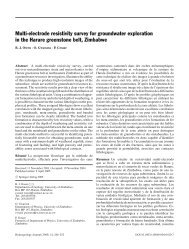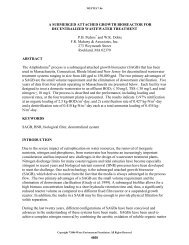Species diversity in the Florida Everglades, USA - Environmental ...
Species diversity in the Florida Everglades, USA - Environmental ...
Species diversity in the Florida Everglades, USA - Environmental ...
Create successful ePaper yourself
Turn your PDF publications into a flip-book with our unique Google optimized e-Paper software.
274 M. T. Brown et al. Ecosystem bio<strong>diversity</strong> <strong>in</strong> <strong>the</strong> <strong>Florida</strong> <strong>Everglades</strong><br />
Figure 8. Expected-to-Observed Emergy Throughput (EOET) vs. Transformity for <strong>the</strong> gram<strong>in</strong>oid marsh.<br />
cally, <strong>the</strong> nearly order of magnitude difference between<br />
wet and dry season transformities – with dry seasons exhibit<strong>in</strong>g<br />
signifi cantly lower transformity values – <strong>in</strong>dicates<br />
dramatic differences <strong>in</strong> resource consumption rates<br />
and process effi ciencies that may be artifacts of <strong>the</strong> data<br />
used. While <strong>the</strong>re is considerable uncerta<strong>in</strong>ty <strong>in</strong> <strong>the</strong> specifi<br />
c values computed for each component, we note that<br />
<strong>the</strong> transformity values obta<strong>in</strong>ed are <strong>in</strong> strong agreement<br />
with similar calculations made us<strong>in</strong>g o<strong>the</strong>r techniques<br />
(Odum, 1996).<br />
While network analyses (Ulanowicz, 1986; Dame<br />
and Patten, 1981) and emergy refi nements proposed<br />
here<strong>in</strong> offer little <strong>in</strong>sight <strong>in</strong>to <strong>the</strong> particular cybernetic<br />
controls provided by each species <strong>in</strong> <strong>the</strong> system, transformity<br />
has been proposed as an <strong>in</strong>formative measure of<br />
<strong>the</strong> expected importance of each component (Odum,<br />
1996). Ulanowicz (1980), <strong>in</strong> develop<strong>in</strong>g <strong>the</strong> ecosystem<br />
concept of ascendency, recognized <strong>the</strong> need to scale fl ow<br />
<strong>diversity</strong> at <strong>the</strong> system scale by total system throughput<br />
to adequately compare between systems. We propose that<br />
system-scale fl ow <strong>diversity</strong> fur<strong>the</strong>r requires adjustment<br />
for energy quality (transformity) before mean<strong>in</strong>gful<br />
cross-trophic comparisons of importance and betweensystem<br />
comparisons of development or stress can be<br />
achieved. As such, we propose an emergy-based ascendency<br />
framework as an avenue of fur<strong>the</strong>r research (see<br />
Christensen, 1994, for a prelim<strong>in</strong>ary effort).<br />
Deviance from <strong>the</strong> Shannon <strong>in</strong>dex maximum, as applied<br />
here<strong>in</strong>, may be a useful <strong>in</strong>dicator of system condition.<br />
This may be true at <strong>the</strong> ecosystem scale and at <strong>the</strong><br />
scale of particular ecosystem component. Our effort to<br />
identify specifi c organisms that exhibit deviation from<br />
expected importance (EOET, measured as a fraction of<br />
expected productivity adjusted for quality) showed <strong>in</strong>creases<br />
<strong>in</strong> EOET with transformity. This observation<br />
suggests that <strong>the</strong> ecosystem is systematically depauperate<br />
<strong>in</strong> <strong>the</strong> upper trophic levels, a conclusion consistent<br />
with <strong>the</strong> documented losses <strong>in</strong> wad<strong>in</strong>g bird populations,<br />
alligators and top carnivores. Notably, those species with<br />
high normative value <strong>in</strong> society (i.e., those for which<br />
wildlife management plans and on which considerable<br />
public scrut<strong>in</strong>y are focused) are generally those with high<br />
EOET values, <strong>in</strong>dicat<strong>in</strong>g <strong>the</strong>ir rarity relative to expected<br />
emergy fl ow contributions. For purposes of evaluat<strong>in</strong>g<br />
ecosystem condition, we would expect that dur<strong>in</strong>g recovery<br />
<strong>the</strong> trend of EOET with transformity would tend towards<br />
no association (r 2 ~ 0). However, were <strong>the</strong> ecosystem<br />
to cont<strong>in</strong>ue to degrade, we would expect an<br />
<strong>in</strong>creas<strong>in</strong>gly signifi cant positive association between<br />
EOET and transformity as lower quality ecosystem components<br />
are selected for, and ecosystem hierarchy and<br />
organization dim<strong>in</strong>ish.<br />
While we would not postulate that all components of<br />
an ecosystem would be present <strong>in</strong> equal importance (and<br />
<strong>the</strong>refore <strong>the</strong>re might be signifi cant variability <strong>in</strong> EOET<br />
even <strong>in</strong> healthy ecosystems), we do expect that <strong>in</strong>tact<br />
ecosystems would demonstrate approximately equal<br />
emergy at all trophic levels, and consequently no systematic<br />
association between EOET and transformity. If<br />
this were not <strong>the</strong> case, net production at one trophic level<br />
would be fail<strong>in</strong>g to generate production at <strong>the</strong> next<br />
trophic level.
















